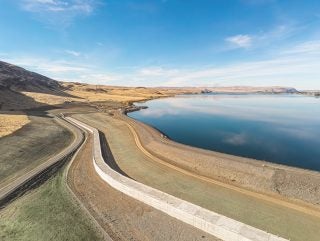
The Priest Rapids Dam is one of two dams on the Columbia River near Mattawa, Washington, which form the 1980MW Priest Rapids Hydroelectric Project. The Priest Rapids development consists of a 3080m long dam constructed between 1956 and 1961. The dam consists of left and right embankment sections, left and right concrete gravity dam sections, left and right fish passage structures with upstream fish ladders, a gated spillway section, and a powerhouse containing ten vertical Kaplan turbine-generator units with a total rated capacity of 855MW.
Public Utility District No. 2 of Grant County, Washington (Grant PUD) is the Federal Energy Regulatory Commission (FERC) licensee and owns and operates the dam. The Wanapum village, a permanent settlement of the Wanapum tribe of Native Americans, is located immediately downstream of the right embankment.
A large section of the existing right embankment is founded on soils that could liquefy during a large earthquake. The Priest Rapids Right Embankment Improvement Project was undertaken as a seismic remediation measure, consisting of a new roller-compacted concrete (RCC) dam constructed directly downstream of the section of the original right embankment that lies on soils that could liquefy during a large earthquake. Beyond the liquefiable zone, the new RCC dam is connected back into the original embankment by a new zoned embankment with an internal plastic concrete secant pile cut-off wall.
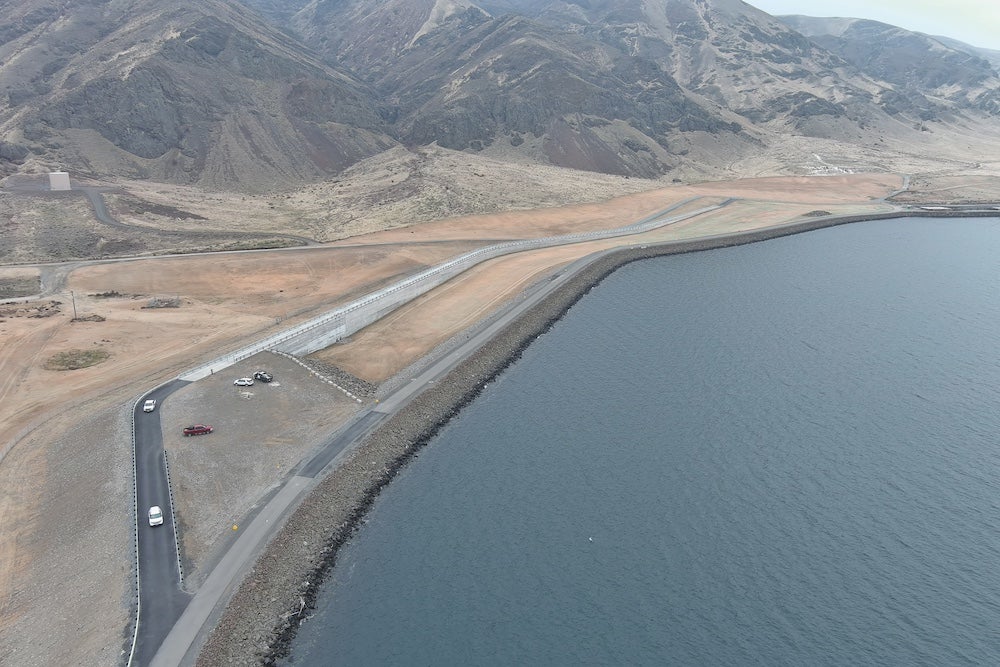
Identifying the problem
Recent seismic assessments indicated that the Maximum Credible Earthquake (MCE) at the dam site is significantly larger than understood when the dam was designed in the 1950s. Following a Potential Failure Modes Analysis (PFMA) workshop that identified seismic stability concerns, Grant PUD engaged Stantec to conduct a multi-phase study to evaluate liquefaction potential, post-earthquake stability, and seismic deformation for the right embankment. The study began with analyses based on existing data and progressed to include phases of geotechnical investigation and more rigorous analyses, and ultimately determined that the foundation soils below a portion of the right embankment dam could liquefy if subjected to the MCE which could result in damage to or failure of the embankment dam.
Since the Wanapum village is immediately downstream of the right embankment, Grant PUD decided to proceed with a remediation project to address the seismic risks, rather than further evaluating the dam using risk-informed decision-making methods.
The solution
The new dam is designed to withstand an earthquake with a moment magnitude of 7.1 and a peak horizontal bedrock acceleration of 0.64g, to retain the reservoir and prevent an uncontrolled release. The dam is 17m high and comprised of a 530m long RCC dam, along with a 53 m long zoned embankment between the upstream face of the new RCC dam and the downstream face of the original embankment. The plastic concrete secant pile cut-off wall in the connecting embankment is 18m deep and 81m long and constructed with 3m diameter piles socketed 1.5m into rock.
The design of the RCC section utilised grout-enriched vibratable RCC (GEVR) for water-retaining barrier along the upstream face of the dam. Excess soil from the required excavation was used to create a buttress along the downstream side of the RCC dam. To save cost, an unformed sloping RCC face was used to construct the portions of the dam that would be covered by fill. Due to the buttress along the downstream side the dam, stability requirements were satisfied without needing to provide drains within the dam or its foundation.
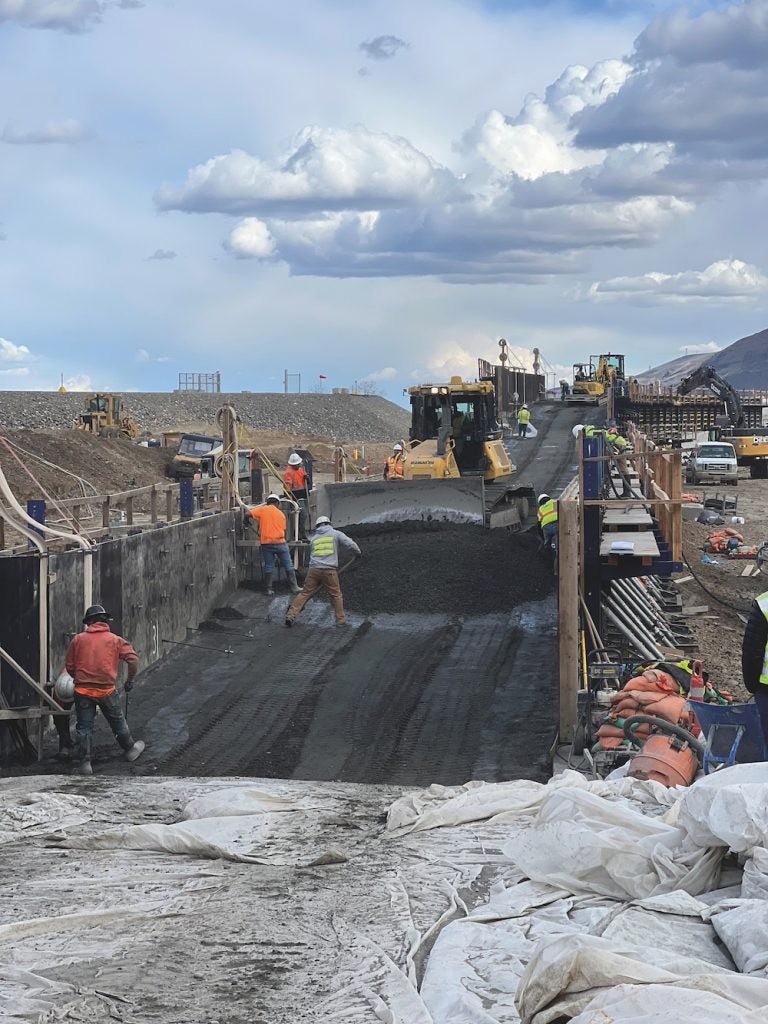
The connecting embankment between the downstream face of the existing right embankment and the upstream face of the new RCC dam was designed largely utilising soil from the required excavation and consists of an impervious core surrounded by filter zones and pervious shells.
The plastic concrete secant pile was designed to provide the water-retaining barrier between the RCC dam and the impervious core of the original embankment. This wall cuts off seepage that otherwise would flow through the pervious shell of the original embankment and its foundation soils. The plastic concrete mix for the secant piles was designed to have similar deformation properties as the embankment fills to minimize stress concentrations during seismic shaking – and thus reduce the possibility of the impervious core cracking – while also providing a durable non-erodible seepage barrier. The secant pile wall was constructed using 3m diameter piles with a centre-to-centre spacing of 2.2m to obtain a minimum wall thickness of 2m, and the wall was embedded at least 1.5m into the basalt bedrock.
By using the plastic concrete secant pile cut-off wall to tie the new dam back into the impervious core of the original dam, the project avoided needing to either drawdown the reservoir or construct a cofferdam for the connection with the right embankment or, alternatively, needing to construct the new dam along the entire 995m length of right embankment.
The existing embankment dam will remain in place. To avoid collecting stagnant water between the two dams, drains through the RCC dam with slide gates were designed to allow for the discharge of water that otherwise could collect between the two dams.
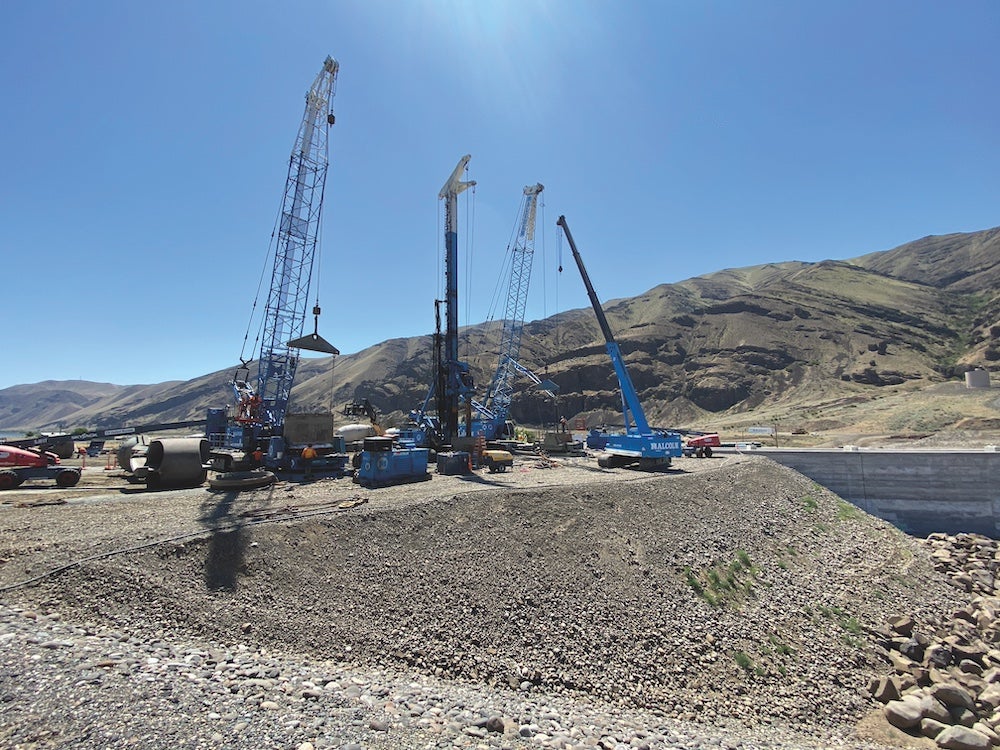
Unique features
The Priest Rapids Right Embankment Improvement Project encountered unique challenges during the construction of a new dam alongside the existing embankment’s toe. Construction staging requirements were developed and assessed to confirm that the new dam’s construction – especially the excavations near the existing embankment –would not impact the stability of the existing dam or disrupt normal dam operations. Detailed stability analyses confirmed that the excavation maintained a safe setback from the existing dam’s toe.
Potential Failure Modes Analysis (PFMA):
A project specific PFMA workshop was conducted prior to construction to evaluate the construction staging requirements, provisions to provide filtered exits for seepage entering the excavation, curtain grouting and foundation preparation measures, RCC and embankment construction, secant pile wall construction, and dam safety instrumentation.
Minimising impact on the Wanapum village:
Given the project’s immediate proximity to the Wanapum village, early and regular consultation occurred during design and construction. Measures were implemented to minimise impacts such as noise, vibration, and dust. Access to and from the village was thoughtfully maintained during construction, with pathways provided to the reservoir and traditional gathering areas. To respect Wanapum religious and cultural practices, construction activities were limited to daytime hours. The use of roller compacted concrete (RCC) instead of an embankment dam reduced the excavation size and minimised construction impacts on the Wanapum village.
Excavation discoveries:
During construction, the excavation for the new dam uncovered two shear zones associated with inactive strike-slip faults, along with several vesicular cylinders in the basalt foundation rock. The vesicular cylinders consisted of vertical concentrations of vesicles that were vapor induced when lava flows encountered surface water, and basalt within and immediately around the vesicular cylinders was typically highly weathered. The planned construction staging allowed sufficient time for investigation and treatment of these unexpected features without major disruptions to the project schedule.
Geologic mapping and foundation treatment:
Geologic mapping of the dam foundation was performed using geographic information system (GIS) tools. Field data collection included rock descriptions and discontinuity information, along with annotated photographs. The GIS database facilitated remote review by FERC, streamlining foundation approvals. To address irregularities in the bedrock surface, leveling concrete was applied, creating a suitable area for the lower lifts of roller compacted concrete (RCC).
Sloping RCC placement:
The general contractor, IMCO Construction, used the sloping RCC placement method which reduced the length and size of the individual RCC placements. This reduced the area of cold joints that would need to be treated whenever RCC construction stopped – which needed to occur daily since work hours were limited to minimize disruptions to the Wanapum village. Such a reduction in cold joint treatment area increased the time available each day to place and compact RCC.
Drilling into an existing embankment:
The construction of the plastic concrete secant pile wall necessitated drilling multiple 3m diameter holes through the impervious core and filter zones of an existing embankment dam with an impounded reservoir. Due to the criticality of the pile drilling, the holes for the secant piles were fully cased and the casing was advanced ahead of the bottom of excavation to minimise disturbance. Water levels were monitored to maintain an outward gradient to ensure that the piles were installed without compromising the integrity of the embankment. Additionally, the secant pile specialty contractor, Malcom Drilling, prepared contingency measures – such as stockpiling material for emergency backfilling of a hole – to address events that could impact quality of the secant pile construction or dam safety.
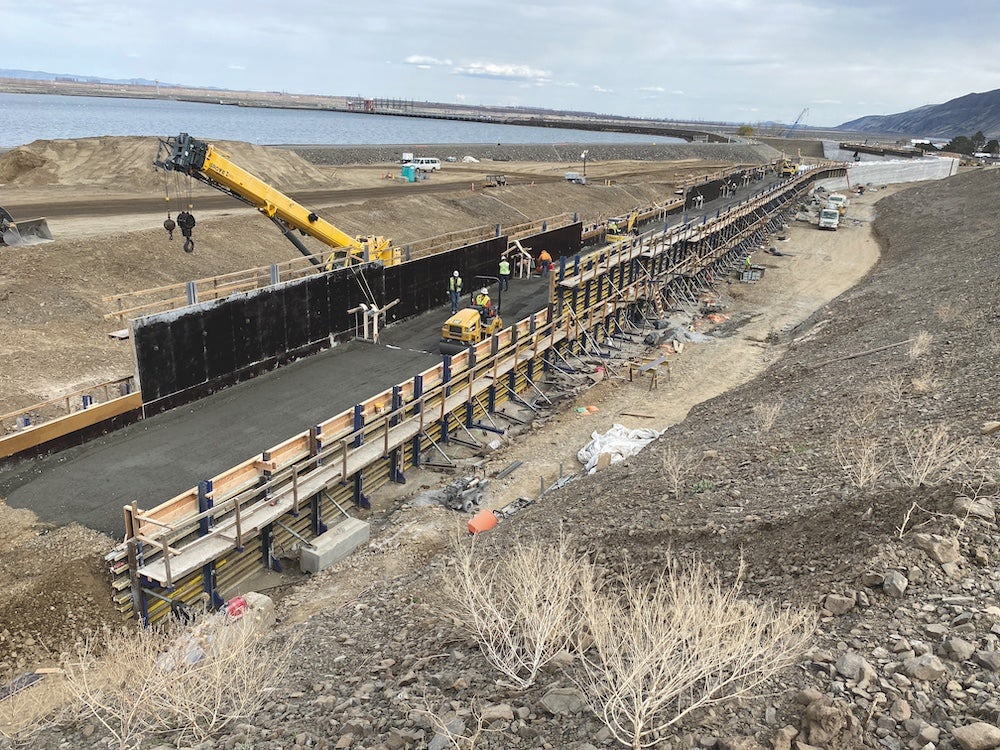
The outcome
The Grant PUD took immediate action upon learning of the increased seismic risk to the Priest Rapids Dam and downstream areas, including the Wanapum village, and the Priest Rapids Right Embankment Improvement Project is designed to withstand a large earthquake and prevent an uncontrolled release of water, proactively addressing the seismic risks. Grant PUD also worked to mitigate impacts on the Wanapum village during construction.
Author information

Hannah Reybrock, Geological Engineer in Training
In her three years at Stantec as a geological engineer in training, Hannah Reybrock has focused on the design and construction of modifications or rehabilitations for hydropower and non-hydropower projects—mostly dams and canals.
She has experience in subsurface characterization, instrumentation, dam safety, and various geotechnical investigations and analyses including seepage and stability for both rock and soil. She’s applied that expertise to projects such as the Priest Rapids embankment improvements and the Red Rock Dam.
Her technical responsibilities include analysis and determination of material properties for rock and soil, site characterization, simplified seismic displacement analyses, stability analyses, and preparation of reports and contract documents. But her real passion? Working on projects across the globe.

Thomas Andrews, Vice President, Energy
Located in Chicago, Tom has over 20 years of diverse project experience in civil and geotechnical engineering for hydroelectric power and dams. His work has included the planning, analysis, design, and construction of hydroelectric projects, dams, locks, tunnels and pipelines, earth work, transmission lines, and substations.
His expertise also covers regulatory compliance and risk analyses—including potential failure mode analyses and semi-quantitative risk assessments—for temporary construction and permanent design conditions.
A vice president on our Energy team, Tom helps to lead projects as well as the teams of professional engineers working on them. His project experience includes serving as lead geotechnical engineer for four new hydroelectric plants on the Ohio River and most recently, acting as project manager for the ongoing Red Rock Hydroelectric Project on the Des Moines River, in Pella, Iowa.






